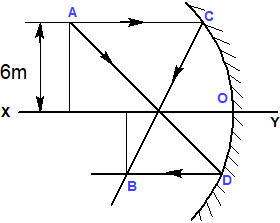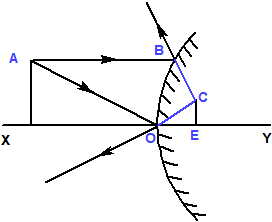
A man having a height of 6 m, wants to see his full height in the mirror. He observes an image of 2m height standing erect, then the type of mirror used is?
A. Concave
B. Convex
C. Plane
D. None of these
Answer
219.6k+ views
Hint: First see at question that man is of height 6m and image is of 2m and it is erect. So, you can observe that the image is relatively smaller than the object. So, you have to make an erect and relatively smaller image. draw images for all mirrors.
Complete step by step solution:
We can solve this question by drawing a picture for every mirror. But first we have to look at the nature of the object and also the nature of the image formed. Here the object is a man that means it is a real object. Here we get an erect image. So, we have to find a mirror which gives an erect and relatively smaller image of a real object. So, there is no condition about whether the image is real or not. Now go for the trials.
First, we are starting with a concave mirror as per the option given. Actually, we are going top to down according to options. Let’s see the first picture.

Here in the picture a ray \[\overrightarrow {AC} \] is towards the mirror. Then it is reflected by a mirror and follows the path $\overrightarrow {CB} $ . here notices that \[\overrightarrow {AC} \] is parallel to the axis of the mirror. Then passing through the focus of the mirror. Another ray $\overrightarrow {AD} $ is going towards the mirror passing through the focus.
When any ray is approaching and passing through, focus is reflected towards the parallel to the axis. It also happened here. The ray is reflected towards $\overrightarrow {BD} $ . So, atlas they are intersecting at point $B$ . Now observe the image. It is a real and inverted image. but it is not matching with our question condition. Then check for the next condition. Draw the next picture for the convex mirror.

Here in the picture a ray \[\overrightarrow {AB} \] is towards the mirror. Then it is reflected by a mirror and follows the path towards infinity. here notices that \[\overrightarrow {AB} \] is parallel to the axis of the mirror. Then pass through the focus of the mirror if you extend it. Another ray $\overrightarrow {AO} $ is going towards infinity. It also happened here.
But if we extend them then it will create an image $\overrightarrow {CE} $ but it is not real. But also, it is smaller in size and also erect which is absolutely matching with our condition. Next for the plane mirror it always gives an image of the same size and erect. So, it is also not matching with our condition. Hence a convex mirror is the correct option.
So, option B is the correct answer.
Note: Concave mirror always gives an inverted, real image. It is a relatively smaller image when an object is placed before the radius of curvature of the mirror. For convex mirrors it forms an erect image and is relatively smaller than the object but it is not real. Next is the plane mirror. It is always an erect, same size image.
Complete step by step solution:
We can solve this question by drawing a picture for every mirror. But first we have to look at the nature of the object and also the nature of the image formed. Here the object is a man that means it is a real object. Here we get an erect image. So, we have to find a mirror which gives an erect and relatively smaller image of a real object. So, there is no condition about whether the image is real or not. Now go for the trials.
First, we are starting with a concave mirror as per the option given. Actually, we are going top to down according to options. Let’s see the first picture.

Here in the picture a ray \[\overrightarrow {AC} \] is towards the mirror. Then it is reflected by a mirror and follows the path $\overrightarrow {CB} $ . here notices that \[\overrightarrow {AC} \] is parallel to the axis of the mirror. Then passing through the focus of the mirror. Another ray $\overrightarrow {AD} $ is going towards the mirror passing through the focus.
When any ray is approaching and passing through, focus is reflected towards the parallel to the axis. It also happened here. The ray is reflected towards $\overrightarrow {BD} $ . So, atlas they are intersecting at point $B$ . Now observe the image. It is a real and inverted image. but it is not matching with our question condition. Then check for the next condition. Draw the next picture for the convex mirror.

Here in the picture a ray \[\overrightarrow {AB} \] is towards the mirror. Then it is reflected by a mirror and follows the path towards infinity. here notices that \[\overrightarrow {AB} \] is parallel to the axis of the mirror. Then pass through the focus of the mirror if you extend it. Another ray $\overrightarrow {AO} $ is going towards infinity. It also happened here.
But if we extend them then it will create an image $\overrightarrow {CE} $ but it is not real. But also, it is smaller in size and also erect which is absolutely matching with our condition. Next for the plane mirror it always gives an image of the same size and erect. So, it is also not matching with our condition. Hence a convex mirror is the correct option.
So, option B is the correct answer.
Note: Concave mirror always gives an inverted, real image. It is a relatively smaller image when an object is placed before the radius of curvature of the mirror. For convex mirrors it forms an erect image and is relatively smaller than the object but it is not real. Next is the plane mirror. It is always an erect, same size image.
Recently Updated Pages
Chemical Equation - Important Concepts and Tips for JEE

JEE Main 2022 (July 29th Shift 1) Chemistry Question Paper with Answer Key

Conduction Explained: Definition, Examples & Science for Students

Analytical Method of Vector Addition Explained Simply

Atomic Size - Important Concepts and Tips for JEE

JEE Main 2022 (June 29th Shift 1) Maths Question Paper with Answer Key

Trending doubts
JEE Main 2026: Application Form Open, Exam Dates, Syllabus, Eligibility & Question Papers

Understanding Uniform Acceleration in Physics

Derivation of Equation of Trajectory Explained for Students

Hybridisation in Chemistry – Concept, Types & Applications

Understanding the Angle of Deviation in a Prism

Understanding Collisions: Types and Examples for Students

Other Pages
JEE Advanced Marks vs Ranks 2025: Understanding Category-wise Qualifying Marks and Previous Year Cut-offs

Understanding Atomic Structure for Beginners

How to Convert a Galvanometer into an Ammeter or Voltmeter

Understanding Centrifugal Force in Physics

JEE Main Marking Scheme 2026- Paper-Wise Marks Distribution and Negative Marking Details

Degree of Dissociation: Meaning, Formula, Calculation & Uses




